Moline Seeks National Endowment for the Arts Funding for Public Art Works
“Our Town” is more than the name of the iconic 1938 Thornton Wilder play. It’s the National Endowment for the Arts’ (NEA) creative placemaking grants program, from which Moline is seeking $150,000 to implement the first two projects recommended in an ambitious, sweeping Public Art and Placemaking Plan.

The public art plan displayed this as a potential “15 Lights” inspiration.
“As Moline and its downtown businesses recover from the economic downtown cause by the global pandemic, creative placemaking is a vital tool in encouraging people to visit and spend time downtown,” according to the grant proposal approved this week by the Moline City Council (starting on p. 209). “There are few grant opportunities that will fund public art to the level available through the Our Town grant.”
The NEA grant requires a partnership between a local government entity and nonprofit organization, one of which must be a cultural organization. Quad City Arts is the lead for the grant application, the city is the primary partner, and nonprofit Renew Moline is writing the grant under the direction of and in partnership with Quad City Arts.
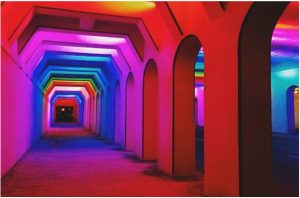
The public art plan displayed this as a potential “15 Lights” inspiration.
Through project-based funding, NEA supports projects that integrate arts, culture, and design activities into efforts that strengthen communities by advancing local economic, physical, and/or social outcomes. “Successful Our Town projects ultimately lay the groundwork for systems changes that sustain the integration of arts, culture, and design into local strategies for strengthening communities,” the city proposal says, noting the NEA grant must be matched by local sources.
The city of Moline is “poised to embark on more robust public art program to beautify the built environment and encourage additional activity and investment in downtown Moline,” the plan says. Seeking matching funds through the NEA’s Our Town grant provides a significant “jump start” on projects identified in the Public Art & Placemaking Plan, which was first released by Renew Moline in late March and presented this week to the city in its final format. “If the grant is received, Moline will have a significant opportunity to jump start its public art investments in downtown Moline,” the council proposal says.
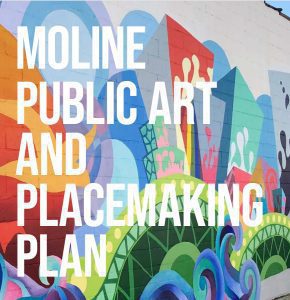
The cover of the 102-page Moline Public Art and Placemaking Plan.
The $300,000 project would include two recommendations from the 102-page public art plan, and an additional one outside its scope:
- The first ($75,000, and not in the public art plan) is the creation of an Uptown Neighborhood Identification Sign, at 16th Street and 15th Avenue, to span over the intersection, create a neighborhood identifier in one of Moline’s historic commercial districts, new city streetscape investments and encourage neighborhood pride.
- “15 Lights” ($150,000), identified in Moline’s Public Art & Placemaking Plan, would be a series of 15 different interactive LED lights on or adjacent to the 15th Street bridge overpass between River Drive and 4th Located at a key gateway between the city’s National Register Commercial Historic District and River Drive, it will illuminate, enhance safety and beautify an important pedestrian corridor and may include small murals or other installations
- “Play at Sylvan Island” ($75,000) was identified by the community during the Public Art & Placemaking Plan outreach. It will encourage recreational use of a small island formerly used for manufacturing, now owned by Moline Parks & Recreation. This location is an important recreational area to an adjacent Hispanic community and the project would complement other initiatives to connect the community to the island.
The Moline Community Development Corporation, Moline Centre, Renew Moline and Quad City Arts met in July to develop a project list that could be submitted under the “Our Town” grant, which NEA launched in 2011. The partners ultimately landed on three proposed projects, which fall under the “Arts Engagement” category of the grant and that represent the project areas of each organization.
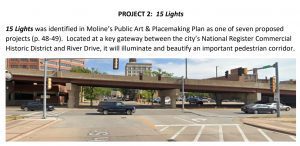
This is the 15th Street overpass targeted for a new “15 Lights” installation in downtown Moline.
The three projects selected are defined as public art projects: A work of art that is conceived for a particular place or community, with the intention of being broadly accessible, and often involving community members in the process of developing, selecting, or executing the work. Temporary public art may be included. These are works that are meant for display over a finite period of time using easily-removed materials, and are often used to prototype an idea, product, or process.
While the proposed match is also significant, Renew will lead efforts to secure other grant funds to minimize the city’s financial contribution. Each proposed project will be conducted independently, artist selection made separately, projects designed independently of each other, but in partnership with the community, and the community will be engaged in developing ideas for the artwork.
The city proposal notes that “Illinois cities are frequently in competition with the Iowa side of the river for development. During the pandemic, Illinois business losses (particularly food & beverage and retail) were exacerbated by the considerably more lenient COVID restrictions in Iowa. The Time is Now: For that reason, there is added urgency to create new reasons to support small business and create pride in the Moline community.
“Recognizing how public art can be a powerful draw for activity and investment, a unique partnership has come together to pursue the Our Town grant,” the plan says. “The City’s non-profit partners, Renew Moline and the Moline CDC; along with Moline Centre (that runs the downtown Special Service Areas and Main Street Program) have each selected transformational projects to create memorable public spaces.”
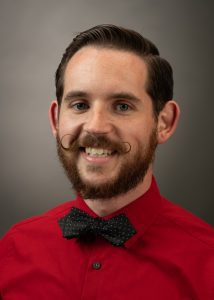
Kevin Maynard is executive director of Quad City Arts.
Kevin Maynard, executive director of Quad City Arts, was a member of the Public Art Steering Committee that guided the development of the plan. He said this past spring, “Public art drives creative placemaking, increases civic pride, and helps strengthen a local economy.
“Pre-Covid, cultural tourism was on the rise and is predicted to return stronger than before and cultural tourists spend nearly twice as much when visiting,” he said. “Additionally, more people are looking at whether a community is rich in the arts when deciding where to locate for a job, especially among younger demographics.”
“A unique partnership has made this Public Art and Placemaking Plan possible. Together, we have established a vision for downtown,” says the public art plan foreword, from Mayor Sangeetha Rayapati, Renew Moline board chair Carrie O’Neill and Moline Foundation board chair Larry Meeske.
“We have laid out our aspirations for corridors and public spaces that are animated and inviting, and specific areas that will be enhanced under this Plan. These spaces will be assets to our public realm and our downtown and will make downtown a more vibrant place to live, work, play, visit and learn. This Plan seeks to implement public art that can be enjoyed by everyone, regardless of age, income, or physical ability. It directs diversity both in the type of art that will be implemented, and in the people it represents. The ideas contained in the Plan were generated largely by stakeholders.
“Despite doing outreach during a pandemic, over 100 individuals participated in various stakeholder meetings, first in person, and then virtually,” the plan says. “Those meetings produced many great thoughts and focused the vision on specific areas and concepts that are the
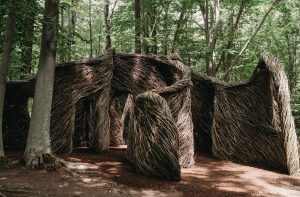
The public art plan displayed this as a potential art feature for Sylvan Island.
basis on which future proposals will be evaluated. Building a dynamic urban core animated by public art contributes to economic vitality by creating places where people want to be and to invest.
“The Plan includes an implementation strategy that offers the opportunity to seek funding through federal, state and local grants along with private and non-profit support; and also uses the development process to focus investments in public art into future development and infrastructure projects. By employing multiple funding sources, the Plan will be both balanced and implemented over time.”
The 15th Street and Sylvan Island projects are among basic components for public art at seven downtown locations listed in the plan:
- Sylvan Island, with environmental art and nature play equipment.
- 19thStreet and 7th Avenue, with pedestrian scale artwork to help improve safety and enliven the area.
- River Drive at new I-74 ramp, with a monumental gateway sculpture that could cost $500,000 to $1 million.
- Welcome words (in concrete or other media) at 19thStreet and 5th Avenue
- 15thStreet overpass at River Drive with 15 interactive LED lights.
- A mural at a blank wall on Analog Arcade Bar, 5thAvenue and 14th Street
- Small lit sculptures at the Q parkway, at northeast corner of 12thStreet and 4th Avenue, at the new rail station.
More public artwork was not sought under the NEA grant since the program really focuses on an entire city, Maynard said this week.
“The public art is more for downtown. Adding another project brings in another section of Moline they’re looking to beautify,” he said. “It also sort of drives home the fact that the public art and placemaking plan does focus on the city of Moline and certain projects, and the city of Moline is making significant investment in public art, not centered just in downtown. So using these funds as a precursor to that does make sense.”
The NEA grant application is due Aug. 17 and recipients won’t be notified of funding until April 2022, and funds can be used through 2023, Maynard said. If they’re able to win the Our Town grant, it will provide a good launching pad for other projects and potential funding down the road.
“By the end of this grant, we will have projects to show we have completed and done, and show as a community, we are making progress, and we can show examples of the work that can be done to potential funders,” Maynard said.
Among Our Town projects done in all 50 states, one of the first was in Dubuque, Iowa in 2011, for Arts in the District, co-led by the city and Dubuque Main Street/Downtown Dubuque Cultural Corridor, a nonprofit organization committed to the economic and cultural development of the city’s downtown area. It received a $100,000 grant for the Historic Millwork District project, which worked with several arts collaborating agencies to help to design not-for-profit art space, new or expanded arts events in the district, and management of the emerging art district.
To see the entire Moline public art plan, visit www.renewmoline.com.













Leave a Reply
You must be logged in to post a comment.